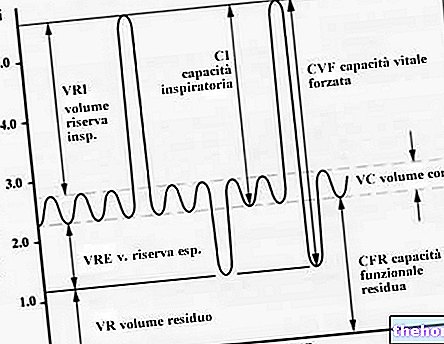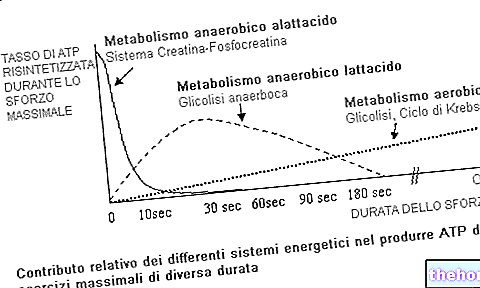Fourth part
Erythropoietin (EPO), factor induced by "hypoxia (HIF) and hyperventilation
EPO has long been recognized as the physiological regulator of red blood cell production. It is produced primarily in the kidney in response to hypoxia and cobalt chloride.
Most of the cells, exposed to hypoxia, put themselves in a state of quiescence reducing the synthesis of mRNA by about 50-70%. Some genes, such as the factor induced by hypoxia, are instead stimulated.
HIF is a protein contained in the cell nucleus that plays a fundamental role in gene transcription in response to "hypoxia. It is in fact a transcription factor that codes for the proteins involved in the hypoxic response and is essential for the synthesis of erythropoietin."
In hypoxic conditions the oxygen sensor pathway (for many cells it is represented by cytochrome aa3) is blocked, so HIF increases. The events that occur downstream of the sensor to activate the expression of the EPO gene require a new protein synthesis and the production of specific transcription factors. In the nucleus, the transcription of the EPO gene on the chromosome begins.

Hyperventilation occurs at rest already starting from about 3400 m (in proportion to the altitude reached). Acute hypoxia stimulates the chemoreceptors (in particular the carotid glomas), sensitive to the lowering of PO2 in the arterial blood, which can cause increase the ventilation up to about 65%.
After a few days of staying at high altitude, the so-called "ventilatory acclimatization" is established, characterized by an evident increase in pulmonary ventilation at rest.
Physical exercise, both in acute and chronic hypoxia, causes hyperventilation much higher than at sea level; the cause would be found in an enhancement of the activity of the chemoreceptors and respiratory centers caused by the reduced partial pressure of O2.
Finally, it should be noted that the energy cost of pulmonary ventilation increases in altitude due to hyperventilation. In fact, according to what was reported in studies conducted by Mognoni and La Fortuna in 1985, at variable altitudes between 2300 and 3500 m, an energy cost was found for pulmonary ventilation 2.4 to 4.5 times higher than at sea level (with the same effort).
The average pH value of the blood under normoxic conditions is 7.4. The hyperventilation that appears in ascension at high altitude, in addition to having the effect of increasing the amount of oxygen available to the tissues, causes an increase in the elimination of carbon dioxide with exhalation. The consequent decrease in the blood concentration of CO2 causes a shift in blood pH towards alkalinity, increasing up to values of 7.6 (respiratory alkalosis).
The pH of the blood is influenced by the blood concentration of bicarbonate ions [HCO3-], which represent the body's alkaline reserve. To compensate for respiratory alkalosis, during acclimatization the body increases the excretion of bicarbonate ion with urine, bringing the blood pH values back to a normal level. This mechanism of compensation of the respiratory alkalosis that occurs in the perfectly acclimatized subject has as a consequence the reduction of the alkaline reserve, therefore of the buffering power of the blood towards, for example, lactic acid produced during physical exercise. It is known in fact that in the acclimatized one there is a notable reduction of the "lactacid capacity".
After about 15 days of stay at altitude there is a progressive increase in the concentration of red blood cells in the circulating blood (polyglobulia), the more marked the higher the altitude, reaching maximum values after about 6 weeks. This phenomenon represents a further attempt by the organism to compensate for the negative effects of hypoxia. In fact, the reduced partial pressure of oxygen in the arterial blood causes an "increased secretion of the hormone erythropoietin which stimulates the bone marrow to increase the number of red blood cells, so as to allow the hemoglobin contained in them to transport a greater quantity of O2 to fabrics. Furthermore, together with red blood cells, the concentration of hemoglobin [Hb] and the value of hematocrit (Hct), that is the percentage volume of blood cells in relation to its liquid part (plasma), also increase. The increase in hemoglobin concentrations [ Hb], opposes the reduction of PO2 and, during long stays at high altitudes, can increase by 30-40%.
Even the O2 saturation of hemoglobin undergoes changes with altitude, ranging from a saturation of about 95% at sea level to 85% between 5000 and 5500 m of altitude. This situation creates serious problems in the transport of oxygen to the tissues. , especially during muscle work.
Under the stimulus of acute hypoxia the heart rate increases, to compensate with a greater number of beats per minute, the lower availability of oxygen, while the systolic stroke decreases (that is, the quantity of blood that the heart pumps with each beat decreases). In chronic hypoxia the heart rate returns to normal values.
As a result of acute hypoxia, the maximum heart rate from exercise undergoes a limited reduction and scarcely influenced by altitude. In the acclimatized subject, however, the maximum heart rate from exercise is very reduced in proportion to the altitude reached.
E.g .: MAX F.C. from effort at sea level: 180 beats per minute
MAX F.C. from effort to 5000 m: 130-160 beats per minute
Systemic arterial pressure shows a transient increase in acute hypoxia, while in the acclimatized subject the values are similar to those recorded at sea level.
Hypoxia seems to exert a direct action on the muscles of the pulmonary arteries, causing vasoconstriction and causing a significant increase in arterial pressure in the pulmonary district.
The consequences of altitude on metabolism and performance abilities cannot be easily summarized, in fact there are several variables to consider, linked to individual characteristics (eg age, health conditions, length of stay, training conditions and altitude habits, type of sporting activity) and environmental conditions (e.g. altitude of the region where the performance is performed, climatic conditions).

As far as the effects on energy metabolism are concerned, it can be stated that hypoxia causes a limitation both at the level of aerobic and anaerobic processes. In fact, it is known that, both in acute and chronic hypoxia, the maximum aerobic power (VO2max ) decreases proportionally with increasing altitude. However up to about 2500 m altitude, athletic performance in some sports, such as 100m and 200m runs, or throwing or jumping competitions (in which aerobic processes are not affected) slightly improves. This phenomenon is linked to the reduction in air density which allows a slight energy saving.
The lactacid capacity after maximal effort in acute hypoxia does not change with respect to sea level. After acclimatization, on the other hand, it undergoes an evident reduction, probably due to the decrease in the buffering capacity of the organism in chronic hypoxia. In fact, in these conditions the accumulation of lactic acid caused by maximal physical exercise would lead to an excessive acidification of the organism, which could not be buffered by the reduced alkaline reserve due to acclimatization.
Generally, excursions up to 2000 m of altitude do not require particular precautions for subjects in good health and training conditions. In the case of particularly demanding excursions, it is advisable to reach the altitude the day before, in order to allow the body to have a minimum adaptation to the altitude (which can cause moderate tachycardia and tachypnea), so as to allow physical activity without excessive fatigue.
When you intend to reach altitudes between 2000 and 2700 m, the precautions to be followed do not differ much from the previous ones, it is advisable only a slightly longer period of adaptation to the altitude (2 days) before starting an excursion, or in alternative to reach the locality gradually, possibly with your own physical resources, starting the excursion from an altitude that is close to those in which you usually stay.
If you make challenging multi-day hikes at altitudes ranging from 2700 to 3200 m a.s.l., the ascents must be split over several days, planning a climb to the maximum altitude followed by return to lower altitudes.
The pace of walking during excursions must be constant and of low intensity to avoid early onset phenomena of fatigue due to the accumulation of lactic acid.
It must also always be borne in mind that already at heights above 2300 m, sustaining training at the same intensity as those at sea level is practically impossible, and with the increase in altitude the intensity of the exercises is proportionally reduced. At altitudes around 4000m, for example, cross-country skiers can withstand training loads around 40% of VO2 max compared to those at sea level which are around 78% of VO2 max. Above 3200 m the demanding excursions of several days, recommend staying at altitudes below 3000 m for a period of time ranging from a few days to 1 week, time for acclimatization useful to avoid or at least reduce the physical problems produced. from hypoxia.
It is necessary to prepare for the excursion with adequate training for the intensity and difficulties of the excursion, in order not to risk endangering one's own safety and that of those accompanying us, as well as that of any rescuers.
The mountain is an extraordinary environment of which it is possible to experience many aspects, abandoning oneself to unique and personal experiences, such as the intimate satisfaction of having crossed and reached magical places with one's own means, enjoying splendid natural environments, far from chaos and pollution. Some cities.
At the end of a "demanding excursion, the feelings of well-being and serenity that accompany us make us forget the hardships, discomforts and dangers that we have sometimes faced.
It must always be borne in mind that the risks in the mountains can be multiplied by the particular and extreme characteristics of the environment itself (altitude, climate, geomorphological characteristics), so simple walks in the woods or demanding hikes must always be planned accordingly and proportionate to the physical conditions and technical preparation of each participant, organizing responsibly and leaving aside unnecessary competitions.
Overall, the studies therefore indicate that, after acclimatization, there is a significant increase in hemoglobin (Hb) and hematocrit (Hct), the two simplest and most studied parameters. he realizes that the results are anything but univocal, both because of the different protocols used and because of the presence of "confounding" factors. It is known, for example, that acclimatization to hypoxia causes a reduction in plasma volume (PV) and consequently a relative increase in Hct values. This process could be due to a loss of plasma proteins, an increase in capillary permeability, dehydration or an increase in diuresidiuresis. Furthermore, during exercise, there is a redistribution of the VP that passes from the vascular bed to the muscle interstitium, due to an increase in tissue osmotic pressure and a greater capillary hydrostatic pressure. These two mechanisms suggest that, in athletes already acclimatized to the " high altitude, plasma volume may significantly decrease during strenuous exercises conducted in hypoxia.
The hypoxic stimulus (natural or artificial) of adequate duration therefore produces a real increase in the erythrocyte mass, albeit with a certain individual variability. In order to improve performance, however, other peripheral adaptations are likely to intervene, such as an increased ability of the muscle tissue to extract and use oxygen. This statement is true both in sedentary subjects and in athletes, as long as the latter are able to train with workloads of adequate intensity to remain competitive.
In conclusion, it can be affirmed that exposure to climatic conditions different from the usual ones represents a stressful event for the organism; the high altitude constitutes a challenge not only for the mountaineer but also for the physiologist and the doctor.
Other articles on "Erythropoietin and altitude training"
- Training in the mountains
- Altitude and training
- Altitude and altitude sickness
- Altitude training
- Altitude and alliance




























